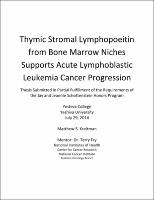Please use this identifier to cite or link to this item:
https://hdl.handle.net/20.500.12202/4157Full metadata record
| DC Field | Value | Language |
|---|---|---|
| dc.contributor.author | Kreitman, Matthew S. | |
| dc.date.accessioned | 2018-11-08T20:12:48Z | |
| dc.date.available | 2018-11-08T20:12:48Z | |
| dc.date.issued | 2014-07 | |
| dc.identifier.uri | https://hdl.handle.net/20.500.12202/4157 | |
| dc.identifier.uri | https://ezproxy.yu.edu/login?url=https://repository.yu.edu/handle/20.500.12202/4157 | |
| dc.description | The file is restricted for YU community access only. | |
| dc.description.abstract | Thymic stromal lymphopoietin (TSLP) is an interleukin (IL), a cytokine produced and released from white blood cells, that is involved in the inflammatory process and cancer (Ziegler et al., 2013). Originally discovered in thymic stromal cells, mouse and human TSLP proteins share significant functional homology. Since its identification, TSLP was also found to be produced in keratinocytes, epithelial, and stromal cells and reported to function as a growth factor that can promote B‐cell development (Ziegler et al., 2013). Moreover, TSLP signaling has been found to increase the risk of acute lymphoblastic leukemia (ALL), a cancer effecting blood lymphocytes. Specifically, TSLP is thought to enhance the survival of these leukemic cells (Chen et al., 2012). The ALL phenotype would most likely be found in clusters or “niches” of the bone marrow (BM), where leukemic cells are created. The identification of the presence of leukemic niches is therefore the first step towards developing the suspected link between ALL and TSLP. Since human TSLP and mouse TSLP share significant functional homology, mouse models have been used to accurately predict the behavior of TSLP in humans. Therefore, the next step towards targeting TSLP signaling in ALL would be to determine whether mouse lymphocytes secrete TSLP. This can be accomplished by measuring relative gene expression levels of Tslp in mouse organs that are lymphocyte‐rich. Along with mouse thymus, mouse bone marrow (BM) showed comparable and significant levels of relative gene expression. This data confirms that TSLP is secreted by cells in the mouse femur BM. The implications to this conclusion may suggest that mouse and human TSLP signaling in BM is involved in the progression of ALL. | en_US |
| dc.description.sponsorship | Jay and Jeannie Schottenstein Honors Program | en_US |
| dc.language.iso | en_US | en_US |
| dc.publisher | Yeshiva College | en_US |
| dc.rights | Attribution-NonCommercial-NoDerivs 3.0 United States | * |
| dc.rights.uri | http://creativecommons.org/licenses/by-nc-nd/3.0/us/ | * |
| dc.subject | Jewish law --Philosophy. | en_US |
| dc.subject | Jewish law --Interpretation and construction. | en_US |
| dc.subject | Jewish law --Methodology. | en_US |
| dc.subject | Orthodox Judaism --History. | en_US |
| dc.subject | Rabbinical literature --History and criticism. | en_US |
| dc.subject | Authority --Religious aspects --Judaism. | en_US |
| dc.title | Thymic Stromal Lymphopoeitin from Bone Marrow Niches Supports Acute Lymphoblastic Leukemia Cancer Progression | en_US |
| dc.type | Thesis | en_US |
| Appears in Collections: | Jay and Jeanie Schottenstein Honors Student Theses | |
Files in This Item:
| File | Description | Size | Format | |
|---|---|---|---|---|
| Matthew-Kreitman.pdf Restricted Access | 525.51 kB | Adobe PDF |  View/Open |
This item is licensed under a Creative Commons License

